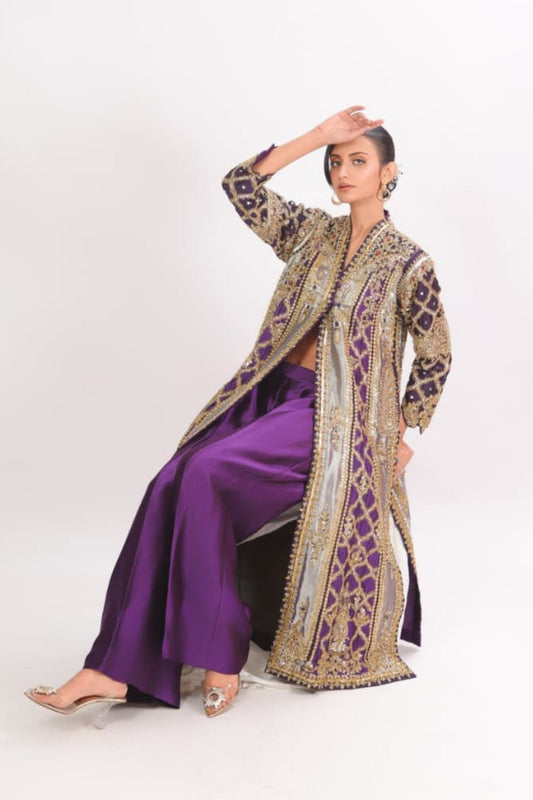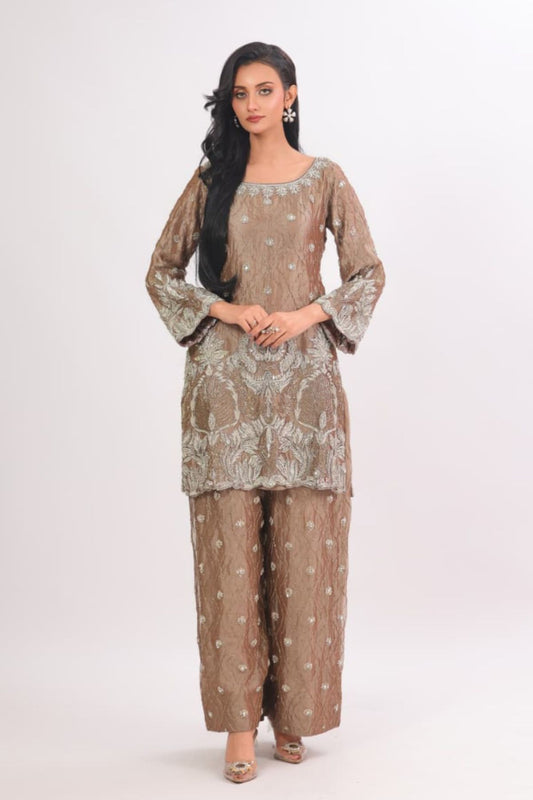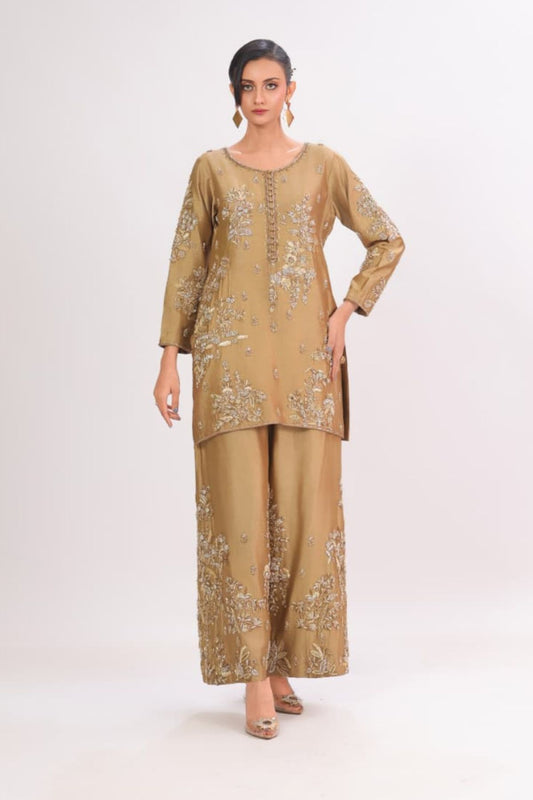Colors of Celebration: A Guide to Choosing the Perfect Formal Dress Color
Introduction
In the vibrant tapestry of Pakistani culture, colors play a central role, and nowhere is this more evident than in the realm of formal wear. Choosing the perfect color for a formal dress is not merely a matter of personal preference; it is a cultural and emotional decision that reflects tradition, symbolism, and the spirit of celebration. In this guide, we will unravel the significance of colors in formal wear, exploring popular choices and their cultural or seasonal associations.
1. The Cultural Symphony of Colors
"The Cultural Symphony of Colors" unravels the profound significance of colors in Pakistani formal wear, transcending mere aesthetics to become a vibrant expression of culture, heritage, and traditions. In this cultural tapestry, each hue takes on a symbolic weight, resonating with the values and emotions deeply embedded in Pakistani society. Beyond being a visual spectacle, the colors of formal wear tell stories and convey meanings that are steeped in tradition. Embarking on a journey through this cultural symphony allows for a deeper understanding of the rich narrative woven into the fabric of each garment. It becomes a celebration of diversity, a reflection of cultural identity, and a testament to the intricate ways in which colors contribute to the collective story of Pakistani heritage.
2. Regal Red: A Symbol of Love and Festivity

"Regal Red: A Symbol of Love and Festivity" explores the profound cultural significance of the color red in Pakistani attire, delving into its rich symbolism and multifaceted roles. The deep and passionate hue of red extends beyond being a mere color choice; it serves as an embodiment of love and festivity deeply ingrained in Pakistani culture. Particularly associated with bridal attire, red symbolizes the profound commitment and auspiciousness of marriage. This vibrant hue, however, transcends the confines of weddings, finding its place in various celebratory occasions, where it becomes a symbol of joy, festivity, and the vibrant spirit of cultural celebration. The exploration of red in Pakistani formal wear reveals a narrative that intertwines tradition, passion, and the blissful celebration of life's significant moments.
3. Eternal Elegance in White and Ivory
While white may symbolize purity in Western cultures, in Pakistan, it represents simplicity, elegance, and new beginnings. Unlike its symbolism in Western cultures, where white represents purity, in the Pakistani context, it conveys simplicity, elegance, and the promise of new beginnings. White, and its subtle counterpart ivory, are chosen not just for their aesthetic appeal but also for the deeper connotations they carry. Ivory tones, in particular, are favored for their timeless and sophisticated aura, making them an excellent choice for formal dresses that exude grace and purity. This exploration reflects the cultural nuances embedded in color choices, revealing how white and ivory transcend mere fashion to become symbols of elegance and the optimism inherent in new chapters of life.
4. Majestic Blues: Tranquility and Spirituality
Blue holds a special place as it symbolizes tranquility, spirituality, and a profound sense of depth in Pakistani culture. The calming hues of sky blue evoke a sense of serenity, while the regal depths of navy convey a majestic and contemplative aura. Blue, versatile in its representation, seamlessly transitions from daytime events to evening celebrations, making it a color choice that encapsulates both calmness and celebration within the rich tapestry of Pakistani cultural aesthetics.
5. Emerald Greens: Harmony with Nature
Green, abundant in nature, is emblematic of harmony, growth, and fertility within Pakistani culture. The rich tones of emerald are frequently chosen for events closely aligned with nature, such as spring weddings, where the color reflects the vibrancy and renewal of the season. Green formal dresses, with their association with nature's bounty, radiate a sense of freshness and rejuvenation, making them a perfect choice for celebrations that echo the vitality and harmony found in the natural world. This cultural narrative underscores how color choices extend beyond aesthetics, becoming a language that communicates cultural values and the profound connection between attire and the surrounding environment.
6. Blush Pinks: A Contemporary Romance
Blush pink, as a modern favorite in Pakistani formal wear, encapsulating the essence of contemporary romance. This tender hue brings a fresh and stylish touch to traditional attire, representing femininity, tenderness, and a modern approach to romance. Blush pink formal dresses have gained popularity for their ability to infuse a soft and romantic aesthetic into cultural celebrations, appealing to those who seek a blend of tradition and modernity in their attire. The exploration of blush pink in the context of Pakistani formal wear reflects not only a shift in color preferences but also a nuanced evolution of cultural aesthetics, embracing the beauty of contemporary expressions of love and femininity.
7. Golden Glamour: Opulence and Prosperity

Gold, with its radiant sheen, is synonymous with opulence and celebration in Pakistani formal wear. Whether featured as intricate detailing or as the dominant color, gold symbolizes prosperity and luxury, making it a timeless and go-to choice for joyous occasions. The rich and regal allure of gold in formal dresses reflects not only a sense of affluence but also a cultural embrace of the grand and the magnificent. As a color that transcends trends, gold continues to shine as a symbol of prosperity, lending an air of opulent celebration to the vibrant tapestry of Pakistani cultural aesthetics.
8. Adapting to the Seasons: A Dance of Colors
The choice of color in formal wear isn't just about tradition—it's also influenced by the seasons. The exploration emphasizes that the selection of colors isn't solely rooted in tradition but is also significantly influenced by the seasons. Warm and vibrant hues come to life in summer celebrations, mirroring the energy and vitality of the season. In contrast, the rich and deep tones of winter bring a sense of coziness and warmth to formal dresses, aligning with the ambiance of the colder months. This seasonal adaptation underscores the cultural sensitivity embedded in color choices, allowing formal wear to not only reflect tradition but also harmonize with the ever-changing natural backdrop, creating a dynamic and visually captivating narrative.
Conclusion
In the intricate dance of Pakistani formal wear, colors are not just chosen; they are embraced as cultural symbols, as messengers of tradition, and as conduits of emotion. Whether you opt for the passion of red, the tranquility of blue, or the opulence of gold, your choice is a celebration in itself—a celebration of joy, love, and the diverse hues that paint the canvas of life. As you navigate the vibrant spectrum of formal dress colors, let your selection resonate with your cultural identity, the significance of the occasion, and the pure delight of celebration. After all, in the world of formal wear, every color is a brushstroke in the masterpiece of your joyous journey.






